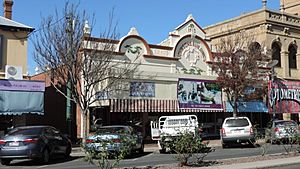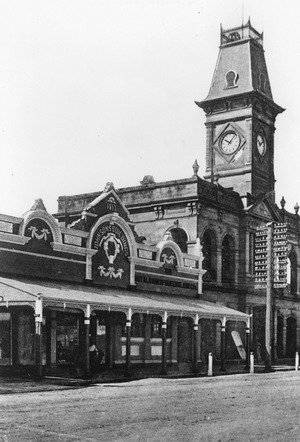Johnson's Building, Warwick facts for kids
Quick facts for kids Johnson's Building |
|
|---|---|

Johnson's Building, 2015
|
|
| Location | 64-70 Palmerin Street, Warwick, Southern Downs Region, Queensland, Australia |
| Design period | 1870s - 1890s (late 19th century) |
| Built | 1898 - 1913 |
| Architect | Conrad Cobden Dornbusch, Hall & Dods |
| Official name: Johnson's Building | |
| Type | state heritage (built) |
| Designated | 11 June 1993 |
| Reference no. | 600960 |
| Significant period | 1890s, 1910s (fabric) 1898-ongoing (historical commercial use) 1900-1930 (bank use) |
| Significant components | out building/s |
| Builders | Daniel Connolly |
| Lua error in Module:Location_map at line 420: attempt to index field 'wikibase' (a nil value). | |
Johnson's Building is a special group of shops in Warwick, Queensland, Australia. It's a heritage-listed building, meaning it's an important part of history and is protected. The building is made up of four single-story shops connected by a cool front design. It stands right next to the Warwick Town Hall on Palmerin Street.
Contents
A Look Back in Time
How It Started
The land where Johnson's Building now stands was first bought by Frederick Hudson in 1857. Later, in 1896, a man named Thomas Alexander Johnson bought the land. He was a very important person in Warwick.
Thomas Johnson was a local leader. He was an Alderman on the Warwick Municipal Council from 1879 to 1898. This means he was like a council member helping to run the town. He was even the Mayor of Warwick from 1881 to 1884! He also held other important jobs, like being a member of the Queensland Parliament.
Building the Shops
The first two shops next to the Town Hall were built in 1898. They were designed by an architect named Conrad Cobden Dornbusch. Daniel Connolly was the builder who constructed them.
In 1900, these shops were changed. They became the home for the Warwick branch of the Royal Bank of Queensland. Conrad Dornbusch also helped with these changes, working for another architecture firm called Hall and Dods.
Adding More Shops
In 1913, the bank's area was changed again. Two brand new shops were built right next to the bank on its northern side. A new, fancy front (called a facade) was added to connect all the old and new parts of the building. These new shops and changes were designed by a local architect, Hugh Campbell. LA Tessman was the builder for this part.
Family Ownership
Thomas Johnson passed away in 1914. His building was then split among three of his children. His daughters, Helena Maria Rowell and Elizabeth Ellen Hardaker, each received one of the new shops (64 and 66 Palmerin Street). His son, Thomas James Johnson, received the part of the building that the bank was renting (68-70 Palmerin Street).
Shop 64 Palmerin Street
From 1932 to 1948, Mrs. Gertrude Florence Jensen rented 64 Palmerin Street. She ran a ladies' fashion shop called "Jennette Salon." In 1948, she bought the shop. Her son, Mervyn W. Jensen, took over the shop in 1989. It still sells ladies' fashion today!
Shop 66 Palmerin Street
Elizabeth Hardaker owned 66 Palmerin Street until she passed away in 1923. Later, in 1949, Mrs. Jensen's son and daughter, Mervyn W. Jensen and Dulcie D. Jensen, bought this shop. It now operates as "Jensens Men and Boys wear."
Shops 68-70 Palmerin Street
The Royal Bank of Queensland (which later became the National Bank of Australia) stayed in Johnson's Buildings until 1930. After the bank left, different businesses rented the space, often running a cafe. Peter Stephanos, one of the cafe owners, bought the property in 1943. In recent years, this larger space has been divided into two separate shops. Today, you can find the Warwick Newsagency at 68 Palmerin Street and the Fair Lady Hair/Beauty Salon at 70 Palmerin Street.
What Johnson's Building Looks Like
Johnson's Buildings are made up of four single-story shops. They are all connected by a fancy front made of stone. Each shop has its own roof made of corrugated iron. At the back, there are wooden additions and other small buildings.
The Fancy Front
The most eye-catching part is the front of the building, above the awning. It has a decorative top edge called a cornice with small block shapes called dentils. This forms a large arch in the middle, with two smaller arches on each side. These arches have swirly decorations on top. The very top of the building has a stepped shape called a pediment.
The top edge of the building is decorated with fancy ornaments and plaster designs that look like drapes and scrolls. The main arched panel in the middle proudly displays the name "Johnson's Buildings." The year "1913" is set into the pediment above.
The awning that sticks out over the footpath today is supported without posts. An older awning used to have posts supporting it.
Inside the Shops
Inside, some of the shops still have their original features. The two shops built in 1913, on the northern side, have beautiful pressed metal ceilings. These ceilings have flower designs in a grid pattern in the middle. The edges and the decorative border (cornice) have a finer flower pattern.
The detailed and decorated front of Johnson's Buildings makes Warwick's main street look very special. This street has many other beautiful and old buildings from the late 1800s and early 1900s.
Why It's Special
Johnson's Building was added to the Queensland Heritage Register on June 11, 1993. This means it's recognized as an important historical site for several reasons:
- It shows how Queensland's history unfolded.
The buildings help us understand how Warwick's business center grew over time.
- It shows what early 20th-century shops were like.
It's a great example of how shops were built and designed in the early 1900s.
- It's beautiful to look at.
The richly decorated front of the building adds a lot of beauty to Warwick's main street, and people in the community really value it.
- It's connected to important people.
Johnson's Buildings have a special link to the life and work of Thomas A. Johnson, a well-known businessman and politician from Warwick, and his family.


